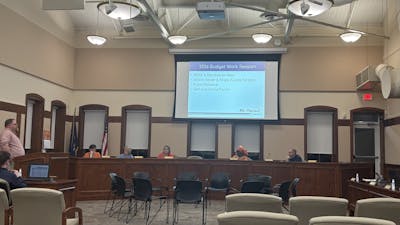Real dialogue: How to have humanizing discussions

Dr. Polly Young-Eisendrath connect ideas from the book Benjamin Banneker and Us to her speech on April 27 in the University Center rotunda.
Psychologist, author, teacher and public speaker Dr. Polly Young-Eisendrath understands: In a conflicted time, the dream of open dialogue and harmony can sometimes feel quite distant.
But she also knows it doesn't have to.
Young-Eisendrath kicked off day two of Central Michigan University’s Diversity Symposium Thursday with her keynote speech, "Humanizing Conflict through Rethinking Dialogue."
While attendees in the Bovee University Center snacked on pastries and sipped on their coffee, Young-Eisendrath talked about her background and how it helped her develop into who she is today. Young-Eisendrath is a clinical psychologist, with work influenced through the ideas of anti-racism and Buddhist teachings.
Dr. Polly Young-Eisendrath gave a presentation on how to have humanizing discussions at the University Center at 8:30 a.m. April 27. Young-Eisendrath is a Clinical Psychologist and creator of the communication method titled Real Dialogue.
She originally thought she was Cherokee as she was growing up, but later discovered she had DNA from the West Indies. Young-Eisendrath said her family and close friends consisted of a lot of African American people, but not many Jewish people. She used this as an example of how perceptions and stereotypes can be created by not being around other ethnicities or races.
Young-Eisendrath also talked a lot about the book, “Benjamin Banneker and Us," by Rachel Jamison Webster. The piece tells the story of Banneker, a Black mathematician, writer of almanacs and one of the greatest astronomers of his generation. Thomas Jefferson hired him in 1791 to help survey Washington, D.C., and Banneker later penned a famous letter to Jefferson pointing out the respondent's hypocrisy of advocating for freedom while he himself owned slaves.
Webster, an ostensibly white woman, learns that this Black groundbreaker was also a distant relative, according to the book's publisher, Macmillan.
According to Young-Eisendrath, the point of sharing information about this book is so people can understand the importance of unity and dialogue even when it may seem futile.
“We’re war-like by nature,” Young-Eisendrath said. “And in order to create a sense of working with conflict in a humanized way, we have to learn how to overcome that destructive nature.”
Young-Eisendrath continued with talks about spacetime and how people cannot perfect everything in their lives. This lead right into her talking about how the University of Virginia is collecting data on children that remember their past lives. According to Young-Eisendrath, the research is not spiritually oriented and most of the kids who remember their past lives had previously passed away during childhood.
Young-Eisendrath said this was meant to connect the idea that tragedy does happen and not everything in life can be controlled. She compared it to wavy water. If you have a surfboard, or in real-life circumstances, resources, you can regain your balance. If not, it makes it harder to obtain control.
The keynote speech continued with the focus of the positive effects that dialogue can have and the negative effects it can have, as well. Young-Eisendrath is the creator of Real Dialogue, a strategy that she said can help people have more productive discussions.
“It moves from objectifying the other person to humanizing the other person.” Young-Eisendrath said.
According to her, real dialogue is not about having a discussion about who is right or who has more facts on their side, it is about understanding the thoughts and experiences of other people and trying to put yourself in their shoes.
She emphasizes repeating back what the other person says and making sure you are understanding them correctly. To do this, Young-Eisendrath said to paraphrase what the other person says and to not move on until both parties agree they understand each other.
“Real Dialogue is not addressed to changing anybody’s mind,” Young-Eisendrath said. “It is addressed to changing the way you connect yourself when you are in conflict -- when you are trying to have a conversation that feels emotionally agitating.”
The presentation ended with a question-and-answer period. To learn more about Young-Eisendrath and Real Dialogue, visit her website or app.






